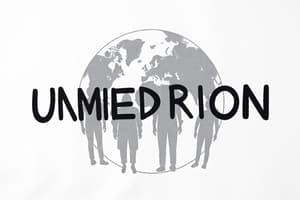Podcast
Questions and Answers
What is a core characteristic of human rights?
What is a core characteristic of human rights?
- Applicable only to citizens of specific nations.
- Granted by governments and subject to revocation.
- Inherent to all individuals regardless of nationality, religion, or culture. (correct)
- Dependent on cultural or religious context.
Which historical period significantly influenced the initial declarations of rights?
Which historical period significantly influenced the initial declarations of rights?
- The Age of Exploration
- The Middle Ages
- The Renaissance
- The Enlightenment (correct)
When was the Universal Declaration of Human Rights adopted by the United Nations General Assembly?
When was the Universal Declaration of Human Rights adopted by the United Nations General Assembly?
- 1776
- 1948 (correct)
- 1919
- 1945
Which of the following is an example of a first-generation human right?
Which of the following is an example of a first-generation human right?
Which category of human rights includes the right to housing?
Which category of human rights includes the right to housing?
Which declaration specifically addresses the rights of children?
Which declaration specifically addresses the rights of children?
In the context of human rights, what does 'inalienable' mean?
In the context of human rights, what does 'inalienable' mean?
Which global challenge is NOT explicitly addressed through the framework of human rights?
Which global challenge is NOT explicitly addressed through the framework of human rights?
How does Article 10.2 of the Spanish Constitution relate to international human rights treaties?
How does Article 10.2 of the Spanish Constitution relate to international human rights treaties?
Which philosopher's advocacy for rights to life, liberty, and property significantly influenced the development of human rights concepts, and what was a central nuance within his arguments that is often overlooked today?
Which philosopher's advocacy for rights to life, liberty, and property significantly influenced the development of human rights concepts, and what was a central nuance within his arguments that is often overlooked today?
Flashcards
Human Rights
Human Rights
Inherent entitlements of all individuals, regardless of nationality, religion, or culture, grounded in the inherent dignity of every person.
Natural Law
Natural Law
Philosophical concept, from the Stoics, that influenced the idea of universal human rights.
First-Generation Rights
First-Generation Rights
Freedoms related to civil and political participation, originating from 17th-18th century revolutions. Examples: expression, assembly, voting.
Second-Generation Rights
Second-Generation Rights
Signup and view all the flashcards
Third-Generation Rights
Third-Generation Rights
Signup and view all the flashcards
Universal Declaration of Human Rights
Universal Declaration of Human Rights
Signup and view all the flashcards
Article 10.2 (Spain)
Article 10.2 (Spain)
Signup and view all the flashcards
Declarations for Vulnerable Groups
Declarations for Vulnerable Groups
Signup and view all the flashcards
Importance of Human Rights
Importance of Human Rights
Signup and view all the flashcards
Study Notes
- Human rights are inherent entitlements of all individuals, regardless of nationality, religion, or culture.
- Human rights are inalienable and grounded in the inherent dignity of every person.
- The concept of universal rights has roots in ancient philosophical traditions, such as the Stoics' notion of natural law
- Philosophers like John Locke advocated for inherent rights to life, liberty, and property in the 17th century
- Liberal revolutions, including the French and American Revolutions, led to initial declarations of rights.
- The aftermath of World War II and the atrocities of Nazism prompted a global effort to safeguard human dignity.
- The United Nations General Assembly adopted the Universal Declaration of Human Rights in 1948.
- The Universal Declaration of Human Rights marked the first time nations collectively recognized 30 fundamental rights.
- These rights include the right to life, education, freedom from discrimination, freedom of thought, and the right to decent work.
- The declaration serves as a common framework for all countries, though its principles are not universally upheld.
Three Generations of Human Rights
- First-generation rights encompass civil and political freedoms like freedom of expression, thought, assembly, and the right to vote.
- These rights emerged from the revolutions of the 17th and 18th centuries.
- Second-generation rights pertain to economic, social, and cultural domains, including the rights to work, health, housing, and education.
- These rights developed in the 20th century.
- Third-generation rights address collective concerns such as the right to a healthy environment, peace, and development.
- These rights are more recent and address global challenges.
- In Spain, human rights are constitutionally protected since 1978.
- Article 10.2 states that rights and freedoms must align with international human rights treaties like the Universal Declaration.
- Since the Universal Declaration, various declarations have been created to protect specific vulnerable groups.
- Important declarations include the Declaration of the Rights of the Child (1959 and 1989) and the Declaration on the Elimination of Discrimination against Women (1979).
- Also significant are declarations concerning the rights of migrants, people with disabilities, and the LGBTQ+ community.
- These declarations reinforce the principle that equality should be universally applied, regardless of age, origin, identity, or status.
- Human rights are crucial in addressing global challenges like war, poverty, forced migration, discrimination, and climate change.
- Human rights help combat injustice, protect vulnerable populations, and build inclusive societies.
- Awareness of human rights is the first step toward defending them and demanding their respect.
Studying That Suits You
Use AI to generate personalized quizzes and flashcards to suit your learning preferences.




